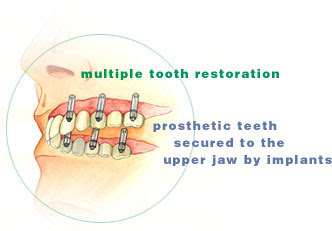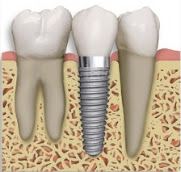If you have recently lost a tooth from tooth decay, gum disease (gingivitis), periodontal disease or from injury, you have probably considered or have been curious about dental implants. This guide will give all the facts and cost related factors which will hopefully answer most (if not all) of your questions so you can decide whether dental implants are the right choice for you.
What is a Dental Implant?
A dental implant is an artificial tooth root. It is inserted into the jaw to permanently or temporarily hold artificial teeth in place. It is typically made out of titanium which is biocompatible with the jaw bone. The direct fusing of bone and an implant is called osseointegration which is a special characteristic of titanium. When a tooth is lost, some bone that helped support the tooth is also lost. Dental implants help stabilize the jaw, preventing future bone loss and maintaining the jaw bone’s shape. Implants are a convenient alternative to dentures because they never have to be taken out and they feel much more natural and comfortable. They are better than traditional bridges and crowns because they aren’t just cemented in place. When mounted to implants, bridges and dentures won’t shift or slip in your mouth, which can make talking and eating easier and worry-free. This also avoids other common problems such as gagging, poor alignment and sore spots.

There are 2 main types of implants. One is called endosteal. This type is implanted directly into the jaw and holds one or more teeth in place. The other type is subperiosteal. This implant is a metal frame that is placed on top of the jaw below the gums. Posts protrude through the gums to hold the prosthesis. This type isn’t as common, but can be used for patients who have minimal jaw height or thickness.
To be qualified for an implant, one must have strong, health gums and jaw bone in order to support it and hold it in place. Routine visits to the dentist and dedicated, comprehensive oral hygiene are both required to maintain implants in the long term (no more skipping brushing your teeth now and then).
The Procedure
Before the surgery can take place, meticulous planning must be completed to identify and analyze nerves, the sinus and the shape and dimensions of the bone in and around the area of interest. During the preliminary examination, your dentist or surgeon will take x-rays of your jaw; paying specific attention to the area that requires a dental implant(s). Different scans can also be taken including a panoramic radiograph, which can show all the upper and lower teeth and bone structure to determine bone health, height and thickness. CT scans are the most accurate form of x-ray imaging to date and may also be used to analyze and determine a treatment plan. Your teeth and gums will be examined for disease and decay and treated prior to the procedure.
Getting implants is an outpatient procedure and can be performed at your local dentist’s office. The operation requires some form of anesthesia including local, general, intravenous sedation or nitrous oxide. Dentists, periodontists and oral surgeons can all perform the surgery.
The surgery itself is normally done in several stages. In the first stage, incisions are made into the gum to expose the bone. A hole is then drilled into the bone so that the implant can be placed. The implant is inserted completely into the jaw bone and lies below the gum tissue (see below). The tissue is then stitched back into place or a temporary covering is used protect the gap from forces such as chewing. As the surrounding bone and gum tissues heal, the implant bonds itself to the bone. The healing process typically takes 4-6 months.
Once the osseointegration is complete, you have to go back to get the abutment installed. The abutment is a post that penetrates through the gums and connects the replacement tooth (or crown) to the implant. The gums above the implant are reopened to install the abutment. This is another outpatient surgery and requires only local anesthesia. Once it is successfully placed, the gum is then closed up around but not over the abutment. In some cases it is possible to install both the implant and the abutment during the same surgery since research has shown that doing so has no detrimental effects as long as adequate time is given for everything to heal. In this case, it is important to note that the post will be visible and care must be taken not to apply any pressure to it during the healing process.
It takes about 2 weeks for your gums to heal before you can finish the procedure. As with any surgical procedure, there will be swelling, bruising, minor pain and bleeding during the healing process.
Next the artificial tooth is made from impressions of your teeth and a model of your bite to ensure that it fits in naturally. Then it is attached to the abutment (it can take several appointments to get the fit just right). A removable prosthesis (or bridge) is conventional if you had more than one tooth replaced. It is also more affordable then implanting each tooth separately as it only takes one implant on either side to span an area and hold several artificial teeth in place. It is similar to dentures, but the difference is that it snaps into place for a more permanent and natural fit.
Advantages and Risks
There are many advantages to tooth implants. It is a permanent solution to tooth loss that is more durable and stable than alternatives such as conventional dentures, crowns or bridges which can make it easier to speak and eat. They also fit more comfortably and naturally and even look better cosmetically which can improve your self-esteem. Convenience is another huge advantage as they do not need to be removed, cleaned or kept in place by messy adhesives. They also improve oral health by making it easier to clean between teeth and they do not require modifications to nearby healthy teeth in order to be installed.
The risks are minimal as problems are rare and are often easily treated. They include but are not limited to: the bone not integrating with the implant, bleeding, injury or numbness of the nearby muscles or sinus cavity due to nerve damage and the chance of infection if the implant breaks, the crown becomes loose or a lack of proper oral hygiene. Success rates depend on a number of factors including the size and strength of the jaw bone and where in the jaw the implant is placed, but overall they are well above 90% (up to 98% if they are properly cared for) and are always improving.
Average Cost and Factors
Tooth implants are typically more expensive than more traditional alternatives. The cost depends on a number of factors including what dentist or surgeon you go to, the type of implant and procedure, how many and which teeth you need replaced, how many implants are required to support these teeth, how much insurance coverage you have and your geographical location. Once you get an examination and talk with your dentist, they will be able to provide you with a price estimate. A single tooth implant typically costs $1000 to $3,000. However, if additional procedures such as bone grafts, extractions and extensive imaging and/or modelling are required, the price can easily inflate to $5,000 to $10,000. Your dentist will be able to give you an idea of what costs you are looking at after a preliminary examination. An implant is only part of the process though. An abutment and crown for a single tooth adds an extra $500 to $3,000. The average total cost paid by consumers for all procedures, abutment, crown and implant is $4,250. A 3 or 4 tooth bridge mounted on two implants can cost anywhere from $5,000 to $15,000 (the average being $8,500). A full set of upper and lower implant supported dentures ranges from $25,000 to $95,000 (average of $34,000), depending heavily on the condition of your gums, jaw bone and existing teeth (if any).
When getting a quote, remember that the total fee includes various aspects of the procedure. There is the cost of the procedure and implant, the cost of the abutment and the cost of the crown or dentures. There could be added charges for the scans, anesthetic and modelling as well.
Insurance Coverage
The first thing you should do is to check with your insurance company to see if implants are covered on your plan. If it isn’t, then you can talk with your dentist’s office to find out if they provide or can recommend other payment plans/options. Remember that your dentist is there for you and will help you in any way that they and give you all the information you need so don’t be hesitant to ask. Unfortunately, many insurance plans cover 10% or less of the total cost of implants, but provide significantly more coverage for more traditional solutions such as dentures. This is often because most companies classify implants and a cosmetic procedure. Surgical costs can be covered by health insurance in some instances.
While losing a tooth can be stressful – remember that there are a number of options available to you, including dental implants. It might seem scary when reading about it, but there is minimal pain, risk and discomfort and the results are lasting and natural looking. Talk to your dentist about implants if you think they might be the solution for you.





























